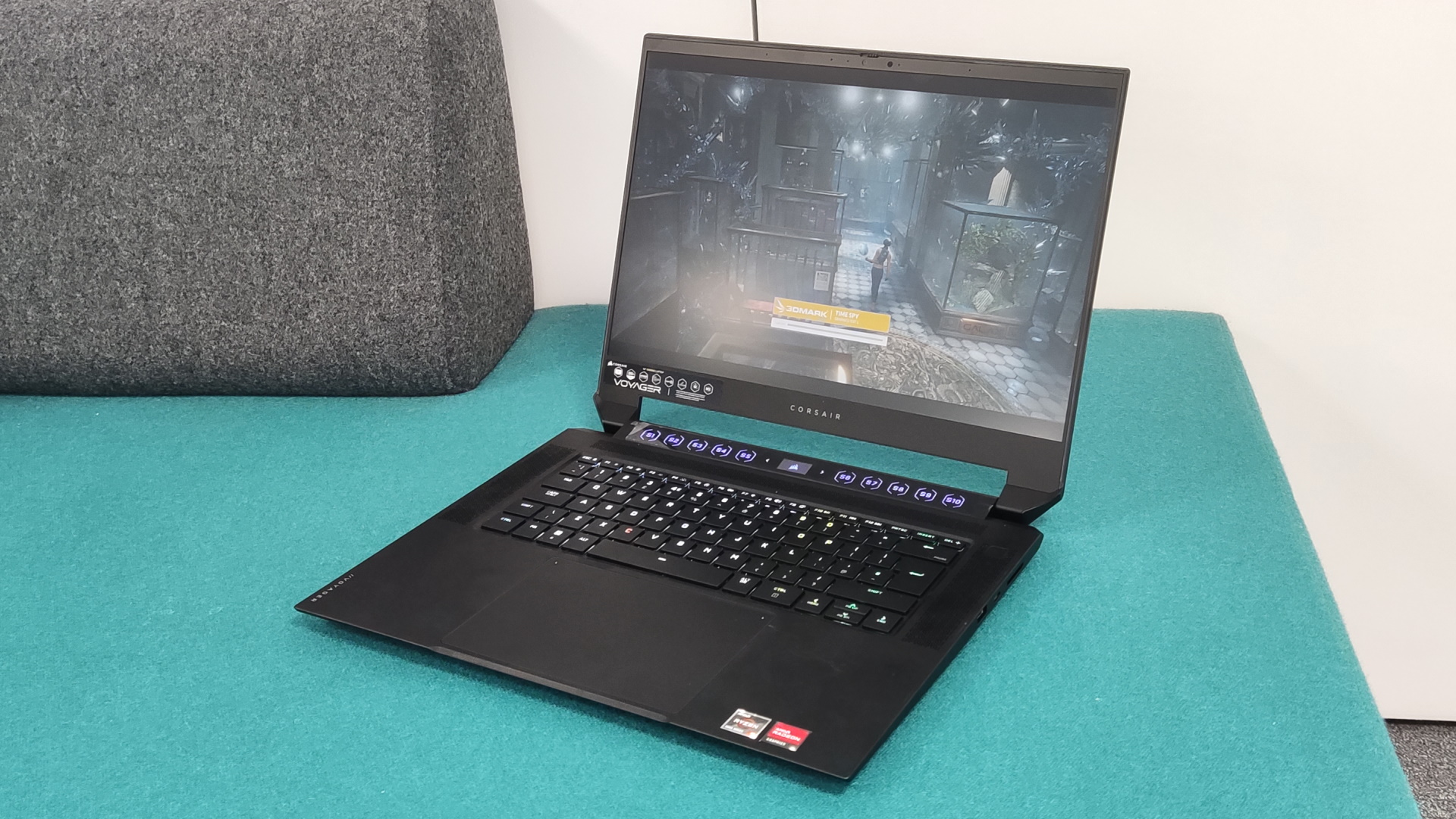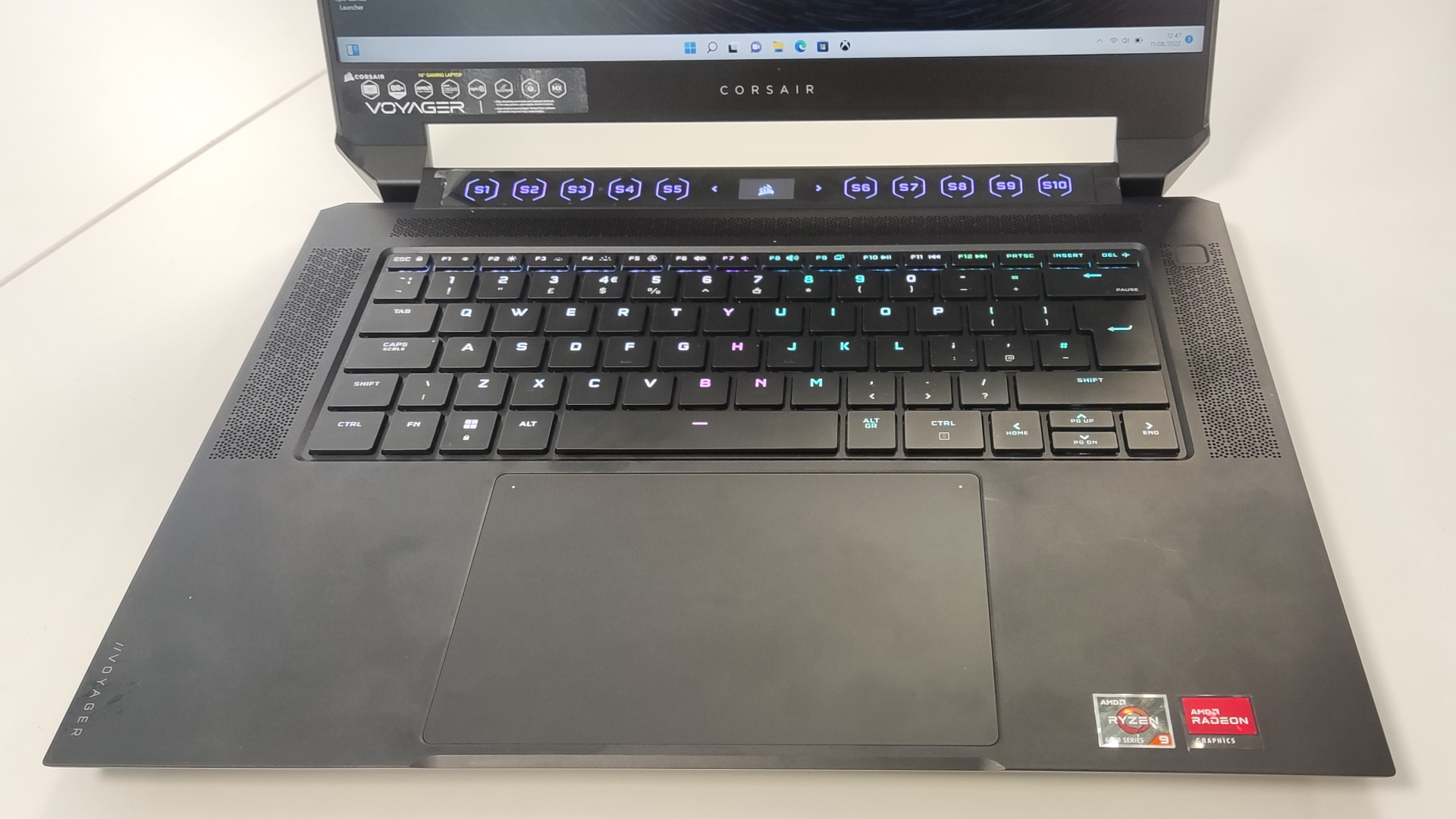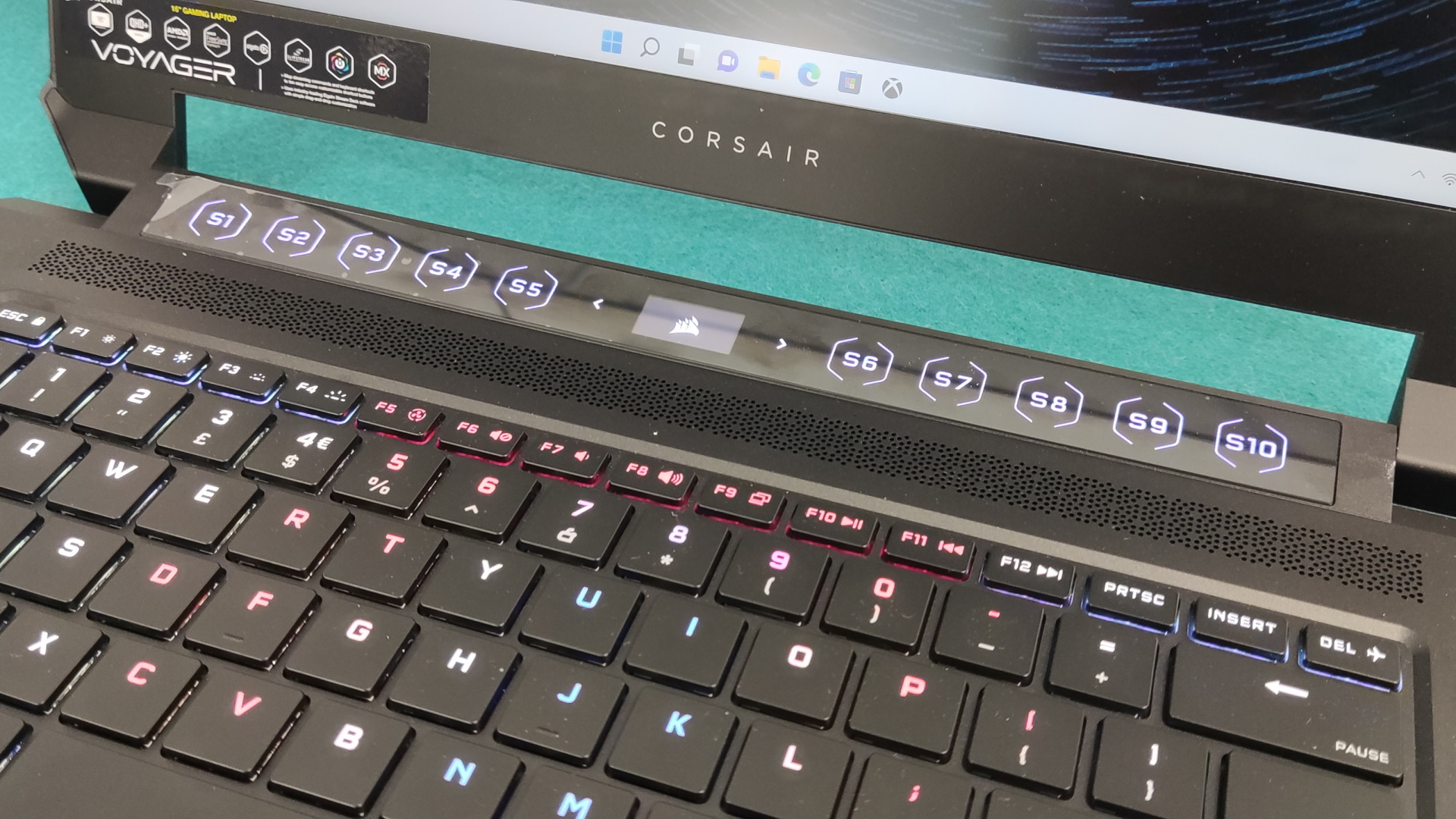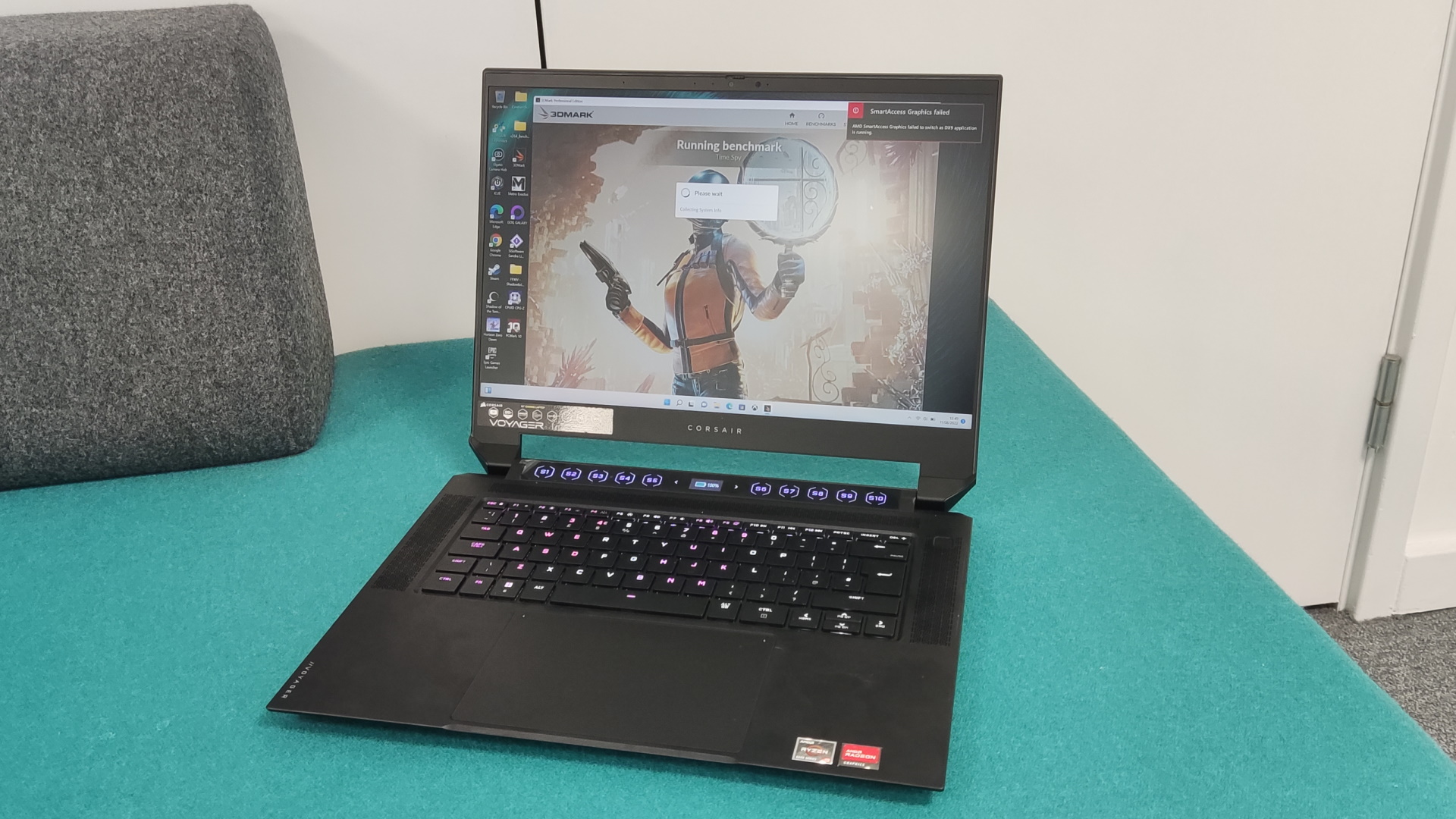Our Verdict
The Corsair Voyager makes for an intriguing laptop for streamers, but it's isn't quite there yet when it comes to functionality and polish. There are some neat features on display—including the best laptop keyboard you'll ever use—but it's a too pricey for the performance on offer.
For
- Wonderfully precise mechanical keyboard
- Vivid 240Hz 16:10 screen
- Great build quality
- Slipstream module works well
- Actually decent battery life
- Integrated Stream Deck buttons…
Against
- …But they're a bit dumb
- No ethernet port
- Annoyingly loud in use
PC Gamer's got your back
Corsair now makes laptops. After launching its impressively compact, if expensive, Corsair One range of PCs, it has now turned its attention to the world of gaming laptops. Not a bad move for a company that made a name for itself with its RAM and PSUs before expanding into the peripheral space. Oh yeah, it also happened to pick up streaming supremo, Elgato, along the way too, which is a relevant piece of info when looking at the Corsair Voyager a1600.
One of the first things you'll notice about the Corsair Voyager a1600 is the row of ten buttons at the back of the keyboard. This isn't just another row of function keys though, and they aren't in fact buttons at all, but rather it's a touch-sensitive strip that integrates with Elgato's Stream Deck software to launch apps, work as a soundstage, start streaming, start a camera call, or whatever else you need.
Between these two banks of buttons, you'll find a small display that can show battery life, the current time, or the CPU load. It's not essential, and it's limited by what else it can show, but it's a neat addition. It does however highlight the buttons themselves are not displays, with is a shame given that's what the Stream Deck itself delivers so well. The accompanying software shows icons for these buttons at the bottom of the main display, but this feels like a stepping stone, not the final destination itself.
The Corsair Voyager a1600 boasts a number of features to help it stand out in the overcrowded gaming laptop marketplace. For starters, Corsair has gone the all-AMD route for the launch of the Voyager, here packing the red team's eight-core, 16-thread Ryzen 9 6900HS alongside its Radeon RX 6800M, including all the optimisations that go with such a pairing. You also get 32GB of DDR5-4800 and a speedy 2TB NVMe SSD for the $2,999 asking price. The $2,699 version comes with 16GB of RAM, 1TB SSD, and Ryzen 7 6800HS, but has the same GPU as this and the same chassis.
You're looking at a slightly bigger machine than is normal, with the 16-inch screen boasting a native resolution of 2560 x 1600. That's a 16:10 aspect ratio, in case you're wondering, while most laptops and desktop displays stick with 16:9. In real terms you have more height to play with, which works well here given the Stream Deck interface takes up the bottom of the display—you can hide this button bar easily enough though.

CPU: AMD Ryzen 9 6900HS
Memory: 32GB DDR5-4800
Graphics: AMD Radeon RX 6800M 12GB GDDR6
Screen: 16-inch, 2560 x 1600 @240Hz
Storage: 2TB Samsung PM9A1 PCIe 4.0 NVMe SSD
OS: Windows 11 Home
Ports: USB 3.2 Type-A, USB 3.2 Type-C, SDXC card reader, 2x Thunderbolt USB4, 1x Audio
Dimensions: 14.01 x 11.28 x 0.78-inches
Weight: 5.29lbs (2.4kg)
Price: $2,999 | £2,999
Given this is a machine that at least to some extent is aimed at streamers, the 1080p webcam shouldn't come as too much of a surprise, and its inclusion benefits everyone, not just streamers. There's a natty little slider to protect your privacy and a four-point microphone array to help capture your voice clearly as well. These do add to the size of the top bezel though, and the bottom of the screen isn't exactly tiny either. In a world of zero-bezel designs, this does feel like a step backwards.
Corsair has also elected to go for a mechanical keyboard for its first laptop, using the new Cherry MX Ultra Low Profile key switches with added Capellix RGB backlighting. And spoiler alert: this is easily the best typing experience I've ever had on a laptop. It feels precise, tight, and delightfully clicky without being overly noisy. There's no numpad, despite the large chassis size, but for once I'm happy to let that go, the overall typing experience is that good. The touchpad is also massive but is responsive and you can elect to only use half the space with a double-tap in the corner too.
Keep up to date with the most important stories and the best deals, as picked by the PC Gamer team.
Corsair has also integrated a Slipstream module into the machine, which means you don't need to leave your USB dongle in the single Type-A USB slot to use your wireless peripherals. It supports up to three devices, and I tried it out using the K70 Pro Mini Wireless, Sabre RGB Pro Wireless, and Virtuoso RGB Wireless XT headset and they all worked flawlessly. It's not essential, but if you already own a few wireless devices, then it's a neat solution for sure.
This is easily the best typing experience I've ever had on a laptop.
Before jumping into the benchmarks, it's worth highlighting that while you're looking at high-end pricing with Corsair's first laptop, amazingly the chip at its heart isn't AMD's top Ryzen 9 mobile chip, that award goes to the Ryzen 9 6900HX. It's essentially the same chip but with two important differences—the HX is unlocked and so can be overclocked, plus it has a higher 45W+ TDP. To get the most from that chip you'd need a chunkier chassis, but it does mean this machine isn't quite using the pinnacle of AMD's laptop range.
There's one more problem on the core spec front for Corsair, and that is that the Radeon RX 6800M isn't the top graphics chip from the red team either. We recently looked at the Alienware m17 R5 that not only comes with the aforementioned Ryzen 9 6900HX, but also ships with the slightly faster Radeon RX 6850M. It has the same 40 Compute Units as the 6800M, but has a higher operating frequency of 2,463MHz as opposed to 2,300MHz, and a faster memory interface too.
Given that machine costs $2,699, the Corsair Voyager a1600 has its work cut out before you even turn it on.
Oh, and before I go any further, there's one thing that Corsair has done with the Voyager that could be incredibly frustrating depending on your setup: it has no ethernet port. No dongle, no flip-down port, nothing. You could absolutely argue that wireless networking has come on a long way, but wired is still the connection of choice for plenty of gamers, particularly if you're working in a busy office with a heavily congested wireless network in place. Or even if you want the fastest connection to the internet.
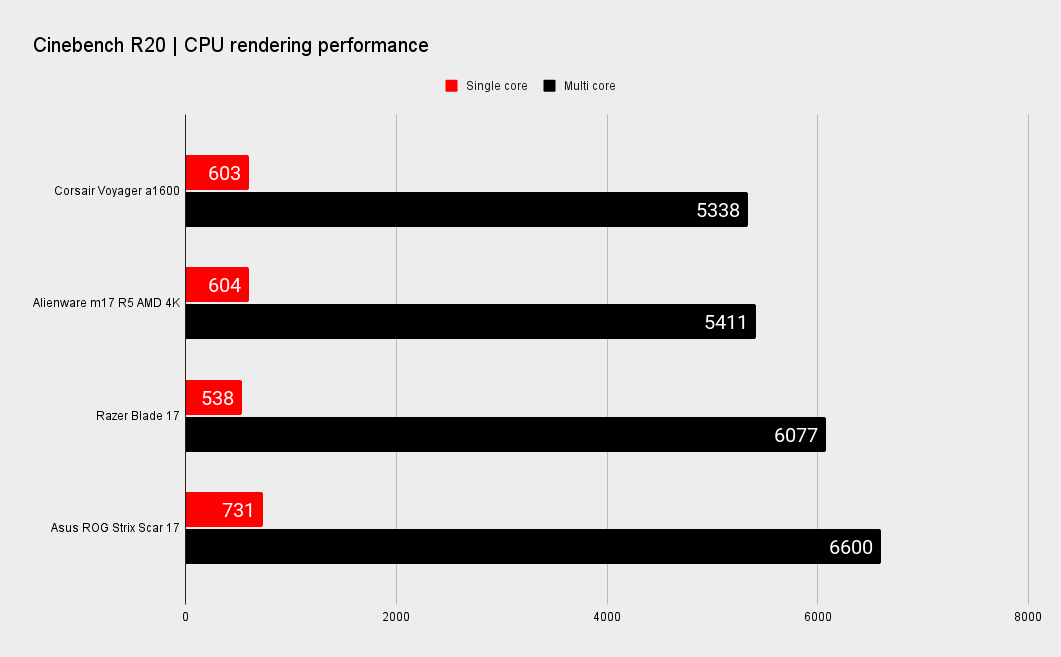
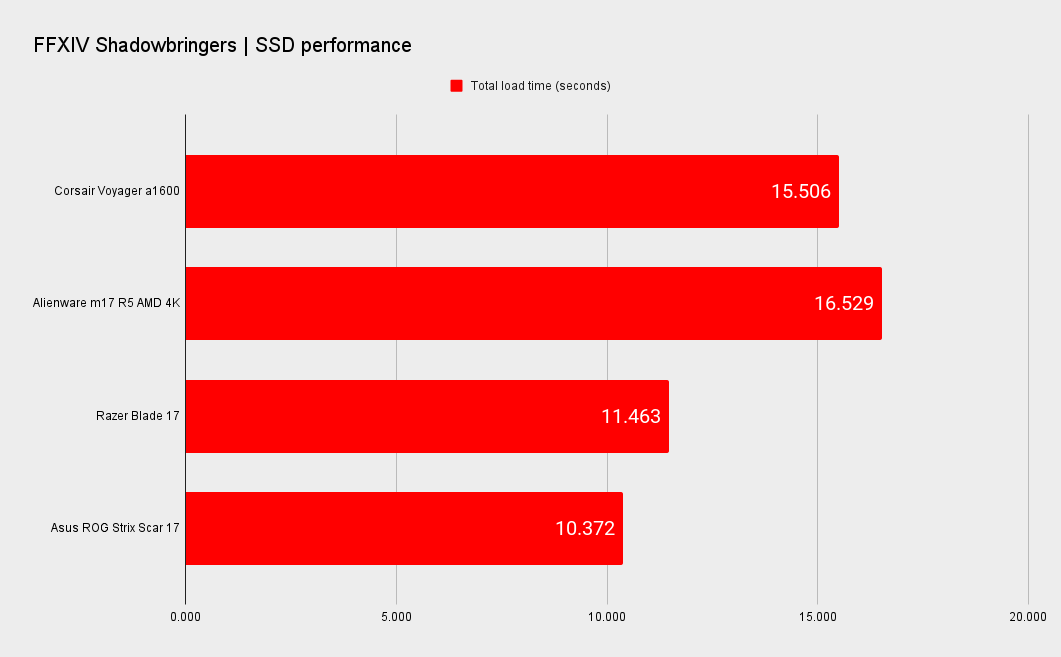
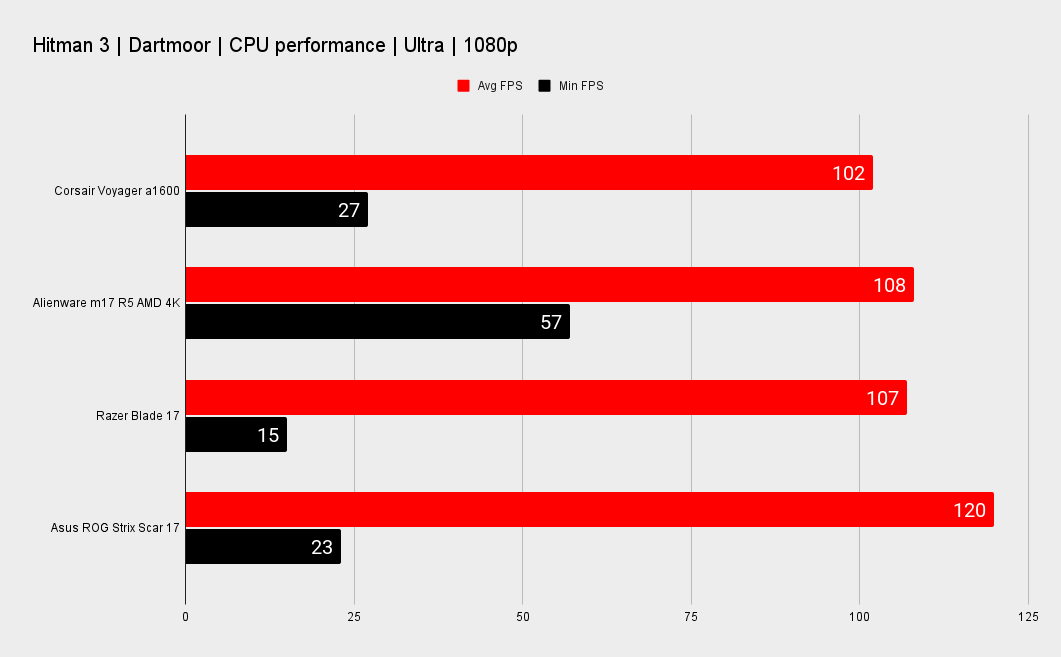

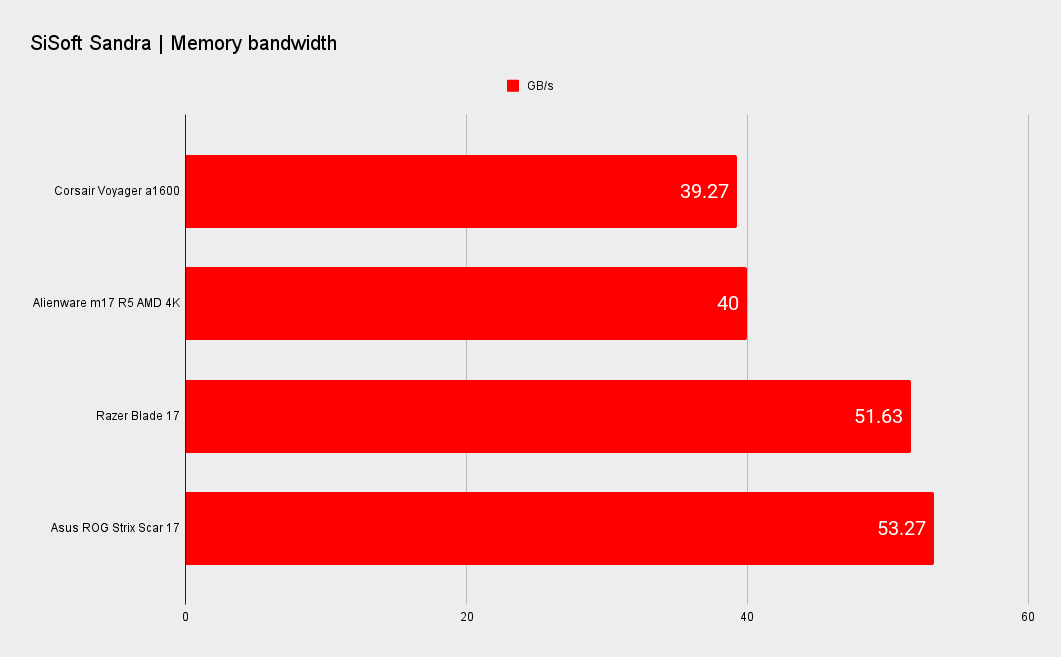
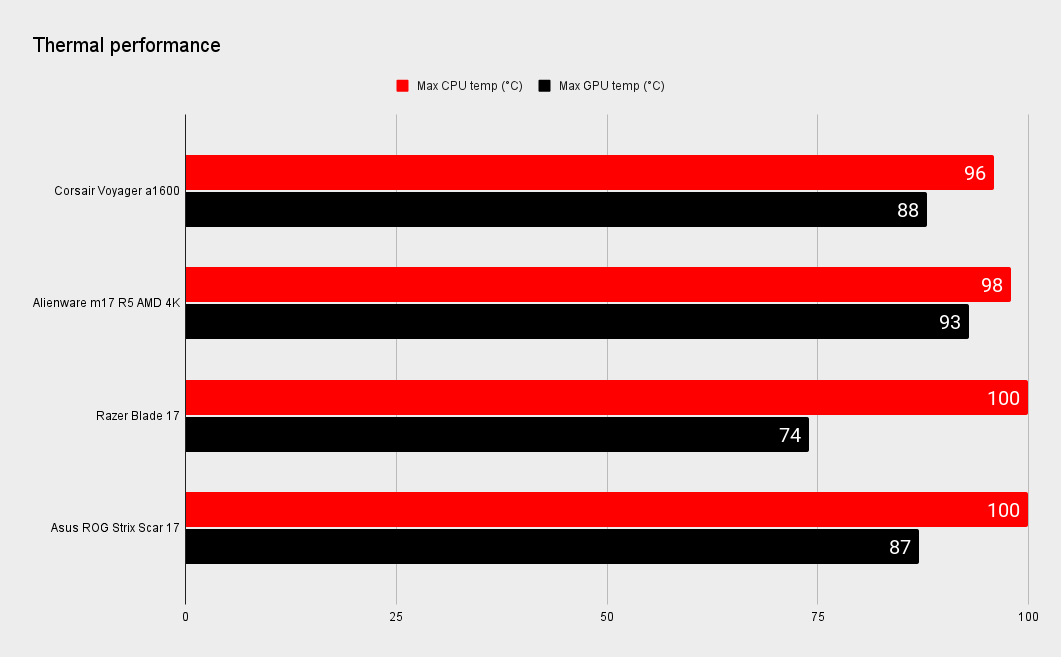
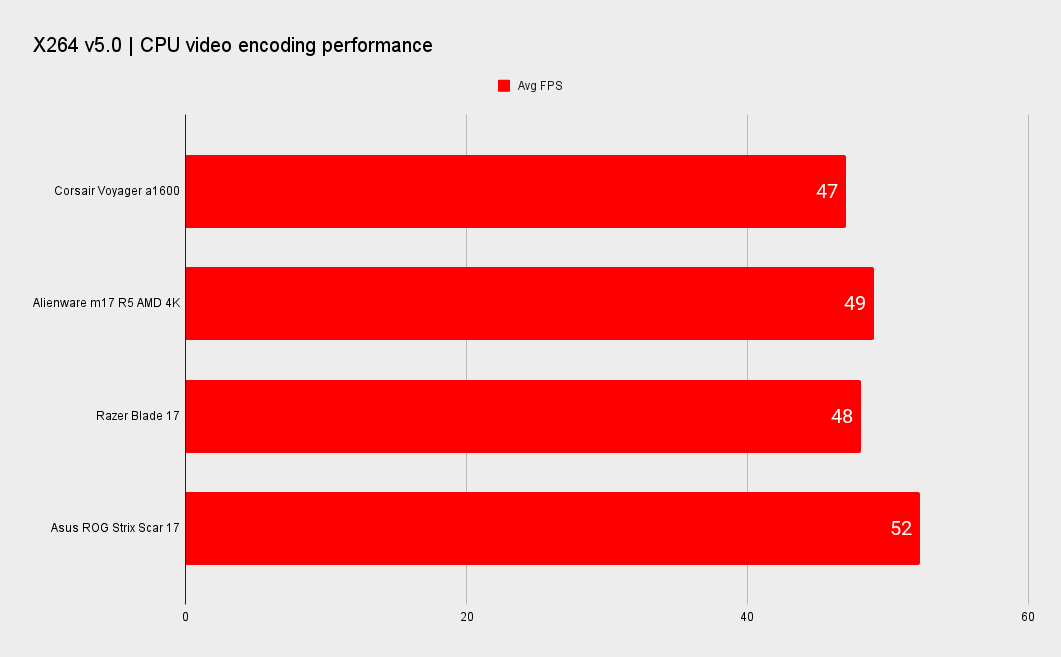
Corsair's decision to go with AMD would have been the obvious choice less than a year ago. Now Intel is back in the game with its Alder Lake CPUs this isn't quite the home run Corsair was probably hoping for. It's a decent performer, make no mistake, but a quick look over the more serious performance graphs shows that this isn't the best option around if you're after the highest performance around.
The Cinebench R20 score has the Intel-powered Asus ROG Strix Scar 17 a good distance ahead, and while this delta is narrower when looking at the X264 video encoding, in terms of raw number crunching it's clear which CPU you want in your high-performance laptop, and it ain't an AMD one.
It isn't a total loss for Corsair and AMD though, and this machine manages something that we haven't seen from a gaming laptop in a long time, a two-hour battery life. Note that this isn't playing back video, or doing normal work, but actually gaming. With plenty of machines dipping under an hour recently, it's refreshing to see this buck that trend. And yes, it means you can actually play whilst away from the mains.
It's a shame that this machine gets so loud in use then. To be fair, by default it uses the Extreme profile in iCue, and there are Quiet and Balanced alternatives. But given you want the most from the machine when gaming, it doesn't feel unreasonable to benchmark it using the best cooling mode. It is annoyingly loud though, and not something you'd want to endure for long periods without reaching for your headphones. It isn't much fun for anyone within earshot.
There is good news on the gaming front at least.

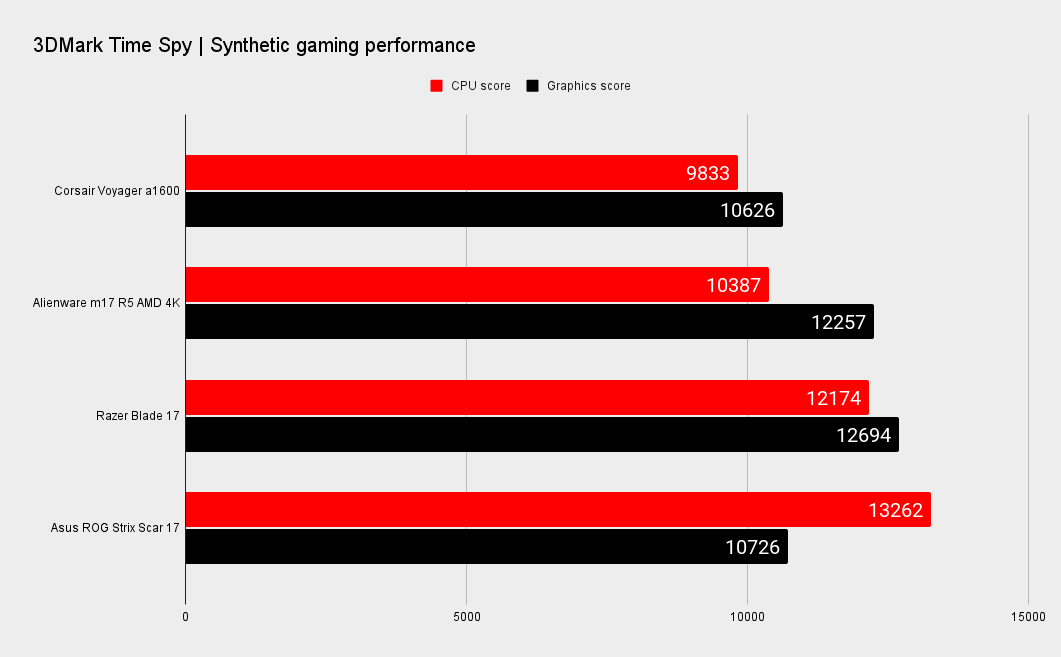
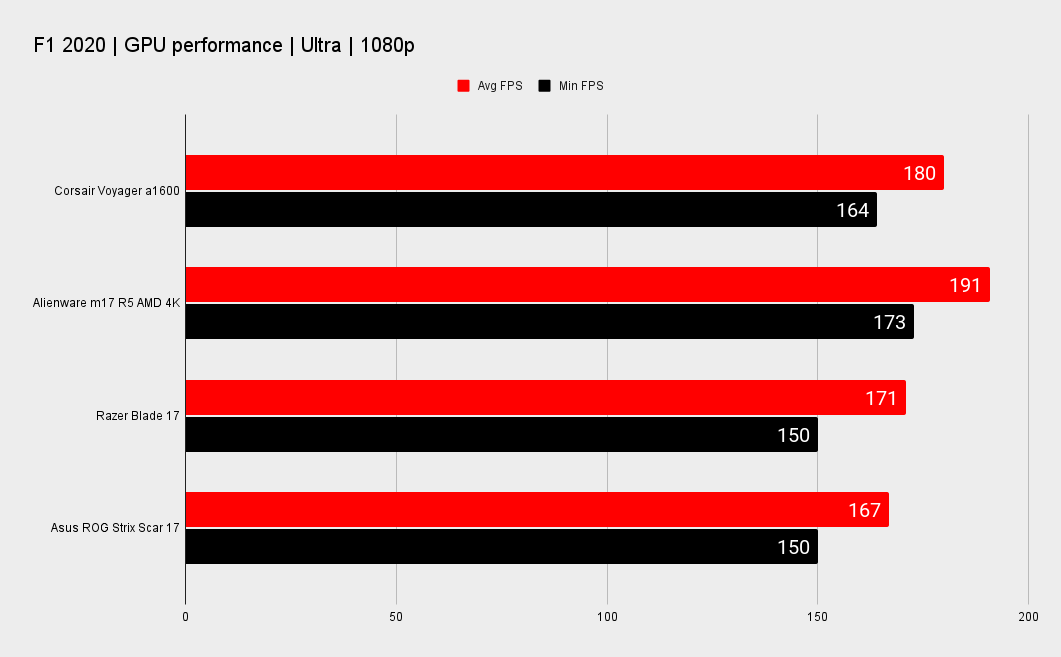

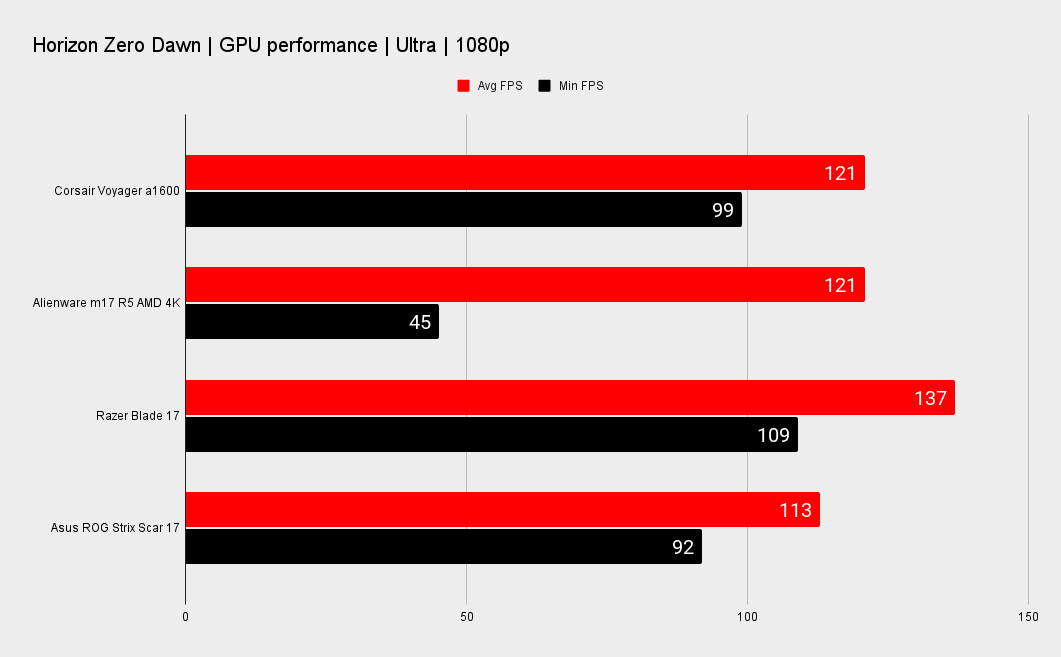

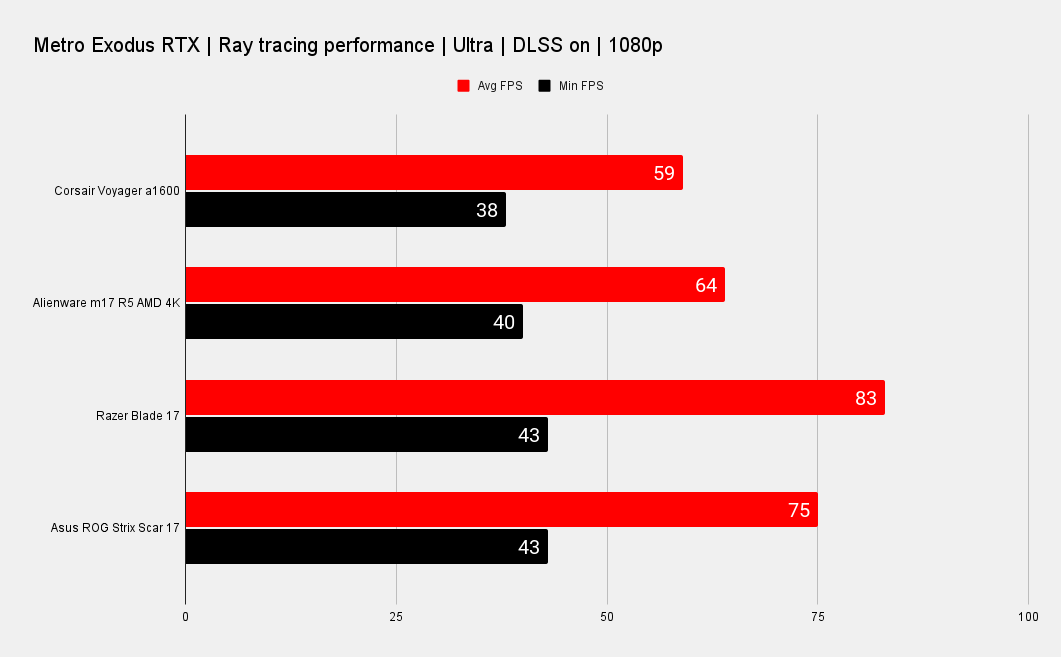
The instant takeaway from the gaming performance of the Corsair Voyager a1600 is that AMD's finest mobile GPU makes for a competitive offering in the laptop market. Exactly as the Radeon RX 6800 XT has on the desktop. Here you're looking at frame rates that are comparable to plenty of mobile RTX 3080s and some high-powered 3070 Tis as well—not a bad place for AMD to sit by any means.
Those GPUs do have DLSS and better ray tracing support to bolster their position, but FSR 2.0 is looking promising and ray tracing is still something of a niche, even midway through 2022.
For comparison reasons we run for laptops at 1080p so you can see how the underlying performance stacks up. And running this machine at 1080p is absolutely an option, potentially a necessity on some games, but you're not getting the full benefit of the display that way. You really want to run it at the native 2560 x 1600, which is a tad more than the standard 1440p resolution, well 160 pixels taller at any rate.
In games, this will affect your performance, but for the most part, there is power available. You're looking at the F1 2022 benchmark dropping from 180fps on average at 1080p to 121fps at native—still plenty fast enough. Horizon Zero Dawn is perfectly smooth at 87fps, while the demanding Metro Exodus dips just under the ideal at 57fps, finally the Dubai test from Hitman 3 averages out a 115fps.
Cyberpunk 2077 is a lot more demanding than our main slew of titles though, managing just 11fps at native using our default choice of Ray Tracing: Ultra setting. Playable frame rates are possible with this game, and it still looks good at lower settings, but without the easy boost that comes with DLSS, ray tracing is too big an ask for AMD's hardware here—even the lowest ray tracing setting tops out at 26fps.
For the most part, this machine is certainly playable at the screen's native resolution. It makes a good pairing for the Radeon RX 6800M that can be found at this machine's heart. It's just a shame the RX 6850M exists and manages to outperform Corsair's offering so succinctly. It essentially means that's the better option, all other things being equal. Yes, there are reasons why you might want the Corsair machine over the cheaper Alienware system, but it's certainly a consideration.

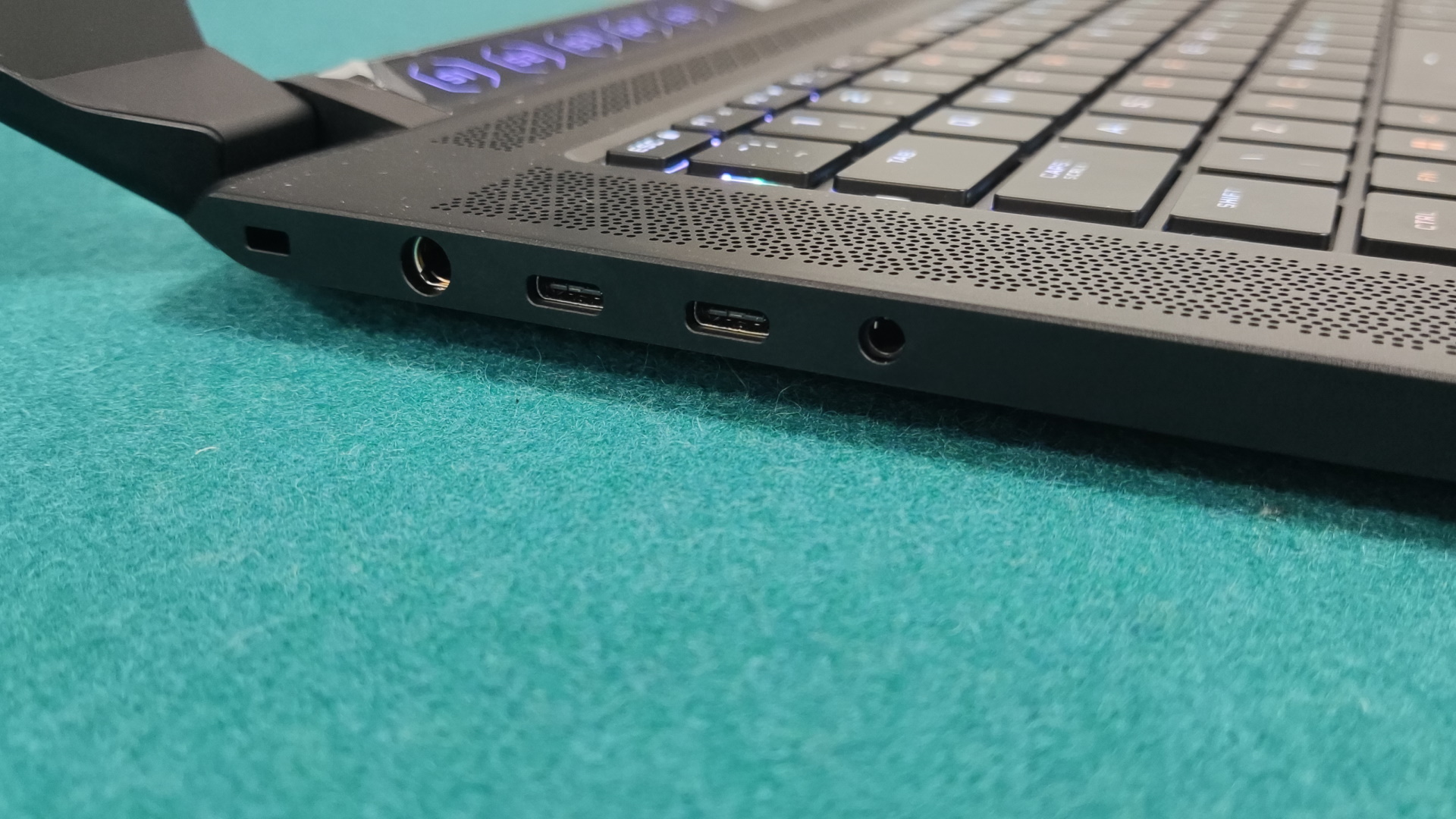

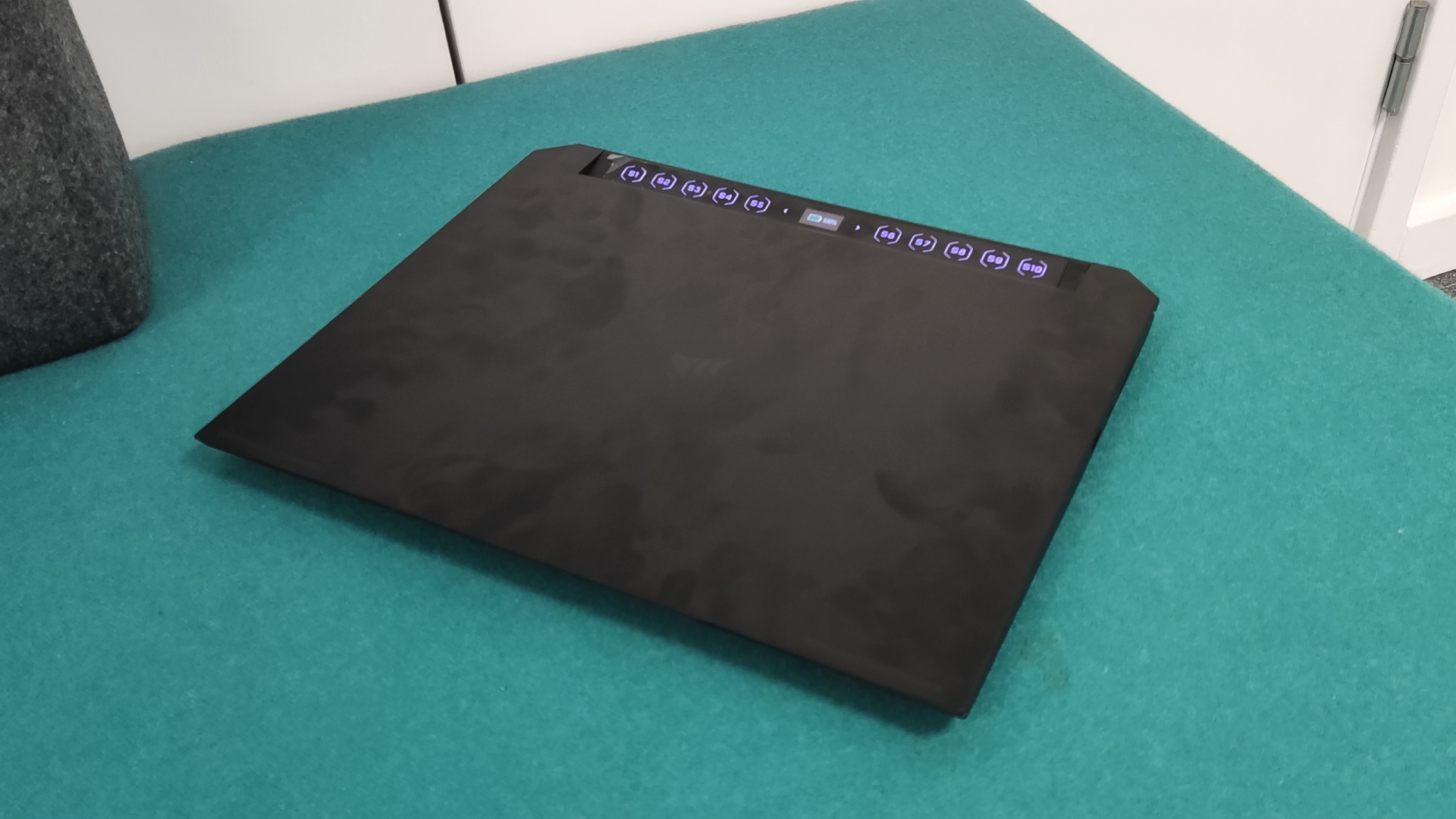
The Corsair Voyager isn't for everyone. The $3K price tag says that succinctly enough, but its niche status is more than simply because it's expensive. This is a machine that is too cumbersome for some (it's a 16-incher that weighs 5.3lbs), not powerful enough for others, and doesn't quite feel fully realised for what it sets out to do. That top button bar isn't essential enough to make me want to seek this out over its peers, and the fact that even Apple couldn't get much traction with its own Touch Bar makes me think it isn't just me.
All this means that while this is a solid laptop in its own right, it's really only going to appeal to Elgato diehards that don't mind paying over the odds for it. And even then, the Stream Deck just feels like a more fully realised solution than some numbered buttons you can change the color of under your main display. A high-end gaming laptop and an Elgato Stream Deck are still going to be the cheaper option.
This isn't a write-off for Corsair though, and if it wants to drop the button bar, ease back on the pricing, and open up the machines to Intel and Nvidia, then there could be something here for gamers. The build quality, choice of materials, integrated Slipstream, and awesome keyboard make this a great machine to use. Just for the love of everything put an ethernet port on it.
The Corsair Voyager makes for an intriguing laptop for streamers, but it's isn't quite there yet when it comes to functionality and polish. There are some neat features on display—including the best laptop keyboard you'll ever use—but it's a too pricey for the performance on offer.
Alan has been writing about PC tech since before 3D graphics cards existed, and still vividly recalls having to fight with MS-DOS just to get games to load. He fondly remembers the killer combo of a Matrox Millenium and 3dfx Voodoo, and seeing Lara Croft in 3D for the first time. He's very glad hardware has advanced as much as it has though, and is particularly happy when putting the latest M.2 NVMe SSDs, AMD processors, and laptops through their paces. He has a long-lasting Magic: The Gathering obsession but limits this to MTG Arena these days.
